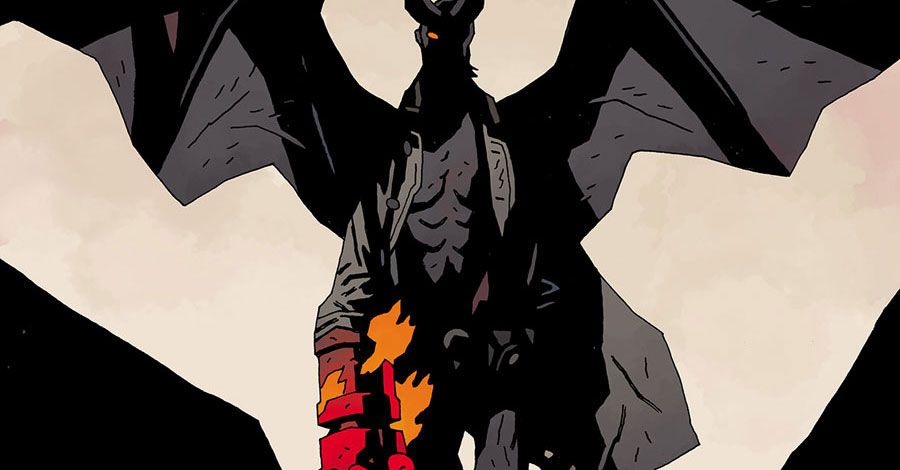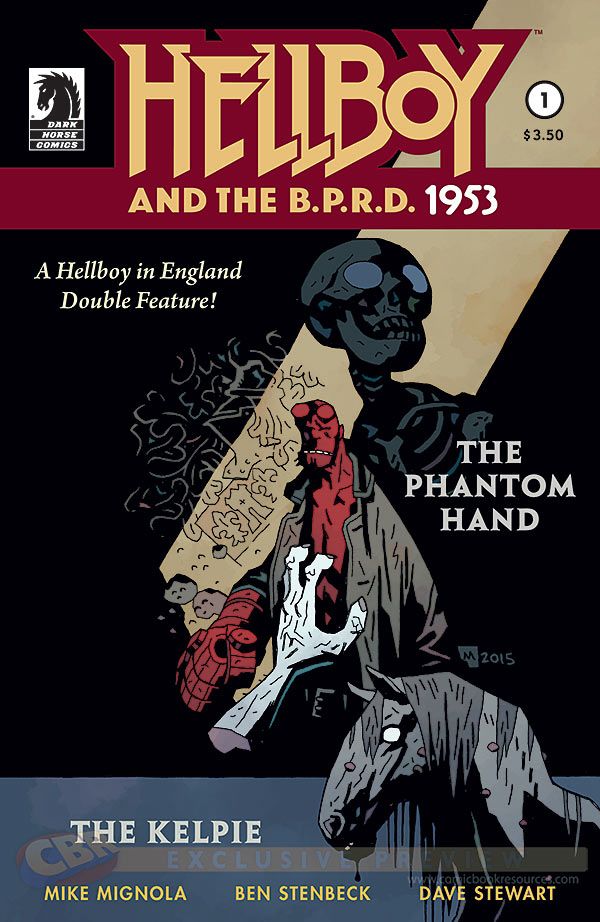Saturday afternoon at the Chicago Comic & Entertainment Expo (C2E2), Mike Mignola led writer Chris Roberson on stage in front of a full room and asked, "Are we in the right place?" The informal atmosphere kept on as the two creators led fans in a discussion in "The Future of the Hellboy and the Mignolaverse."
However, as things got underway Mignola joked that the panel would better be described as "The Early Days & The End Days of Hellboy," and that without Roberson on the stage, it would be a short panel because it would consist of Mignola going, "I'm done!" But even though the creator of Dark Horse's big red agent of the B.P.R.D. is stepping aside from his signature character for the foreseeable future after the impending end of "Hellboy In Hell," the characters of that world will continue on.
RELATED: Mike Mignola Announces the End of "Hellboy in Hell"
"I spent the last 20 years rereading the Mignolaverse books about every two years," Roberson said of his connection to the material. "It's become increasingly time consuming because they keep making them." The writer was brought into the fold when Editor Scott Allie offered him a chance to pitch on the tie-in title "Witchfinder" -- a series which has not yet seen the light of day. It came out that Roberson was an early champion of Dark Horse work for the most recent Witchfinder writer Kim Newman from his days writing mostly prose fiction. And so Roberson's own pitch built strongly on the material seen in the "Mysteries of Unland" series, which impressed Mignola, led to more work in the line.
Roberson said swimming in that big history of Hellboy and company was the joy of working on books like "Hellboy and the B.P.R.D.," though he's had to work hard to piece together the thread of the main story for the character because "it's been revealed a panel or two at a time."
"I don't even keep it straight," Mignola admitted. "But I have enough of a memory that I can go 'I know somewhere in one of the book, we revealed this... sort of.'"
All that means that the current plan for the character is to flesh out secrets of his past, with Roberson's help. "Regardless of the fact that he's sort of ending in 'Hellboy In Hell,' there are more stories to tell in this world -- with or without Hellboy. This is a cool world full of monsters," the artist said. One of the benefits to having other creators help do this is that Mignola never wanted to draw things like Hellboy sitting in a car, so many of the common areas covered by period adventure stories have been off limits until now.
Fan questions started up, and Mignola started by telling an audience member exactly how one character in a few mini series could spin off into a whole world of books created with other writers and artists. He said that early on in the character's saga, he realized that he was increasingly pushing characters like Liz Sherman and the B.P.R.D. out of the book in order to focus on what he wanted to draw. As a result, John Arcudi was brought in and began to expand the world out quickly.
"It was never a plan, but it was just that there were too many stories for me to do by myself," Mignola said. "I guarantee that it was never us going, 'Hey, let's make a shitload of money.' That still hasn't happened... The beauty is that we've never thrown the door so wide. We've had me, Arcudi, Scott Allie and now Chris. Josh Dysart was in there for a minute, but it's been a very small group. I want guys I'm comfortable with because, like with Chris, I'm able to let him do what he wants to do."
The artist compared the building of the Mignolaverse to the early days of Marvel Comics where there was a common feel to the world and the characters, but while Marvel eventually collapsed under the weight of its history, Hellboy's world has remained somewhat controlled. But the creator of that world is loathe to go too far in explaining exactly how it all fits together. "I don't want to take the mystery out of what I love about mythology and folklore," he said. "As soon as you explain everything about mythology, it's not fantasy anymore. It's science fiction... I don't want to spell it out too clearly because then you've written yourself into a corner and you're stuck with some science fiction bullshit."
Roberson pointed out that there was something close to an explanation of how everything fits together in the world in one of the "Hellboy In Mexico" stories, but Mignola countered that whenever he does a scene like that, he has an insane person deliver the explanation to keep things in doubt. He did say that in the final issue of "Hellboy In Hell," there's an important scene where some demons get together and take a crack at explaining the makeup of Mignola's Hell in a somewhat Shakespearean form, but it's a rare thing for him to go that far in giving explanations.
A fan asked if Mignola could share any anecdotes from working with Guillermo del Toro on the "Hellboy" films. "There's always been a little competition between me and del Toro, and I looked at him one day and said: you win," he said. "Because I know that someday if I get run over by a bus, Entertainment Tonight or something is going to run a story where they say, 'Mike Mignola, creator of Hellboy is dead,' and they're going to show a picture of Ron Perlman." Mignola said that he realized when a movie is made of your work, you're always going to be in the shadow of that mass media representation, but you have to own it. He said because of the movie, the books have sold better, he's had a dinosaur named after his character, and he's been referenced on TV shows from "Jeopardy" to "ER."
The pair talked up how they're working on the new Hellboy material -- largely finding ideas that Mignola never had the time for and fleshing them out in the past of the world. The artist asked the audience what elements of the Mignolaverse they'd like to see brought back, and answers ranged from robots to Hyperboria to Lobster Johnson to Baba Yaga. "Nobody wants the caveman guy?" he asked.
Over the years, Mignola has been obsessed in his comics with the idea of Ragnarok -- an ending to the world that also serves as a new beginning. He said that was the initial motivation of Rasputin in the book because "I've never been able to write a bad guy who just says, 'I'm evil.'" He said he couldn't tell the room where the world is going, but he did promise that more stuff would be blown up before the world could be reborn again.
Roberson asked Mignola whether the most recent Hellboy series was his most personal work in a long time. "'Hellboy In Hell' is really Hellboy back inside my head," he said in response. "I went through this very bad stretch where I was really having trouble with it. I couldn't draw the comic anymore. The movie stuff was going on. I brought Duncan Fegredo on... but I knew that I wanted to come back, and I wanted to put him in my world. If you look at 'The Amazing Screw-On Head' or 'The Magician and the Snake,' that was my world. There were these old buildings and these Victorian guys running around. That's what my Hell is. It's the stuff I wanted to draw."
Mignola said that despite how all the piece of his world fit together in a tenuous way, he will never have Hellboy crossover with Lord Baltimore -- the vampire hunter he created with Chris Golden. He likes to let his collaborators run with their ideas, and trying to bend Baltimore into the Mignolaverse runs counter to that idea.
Asked about whether he and del Toro had ever discussed their competing endings for the comic Hellboy story and the proposed third film of a trilogy, the artist said they hadn't. "I don't know how his third movie would end. I didn't want to know, and I don't think he wanted me to know," he said, adding that every time they've discussed any ideas about anything -- from a trip back in time to Japan, to an appearance by Lobster Johnson -- the director has said, "That'll be in the third movie." Mignola joked that if every time del Toro said that were true, the third Hellboy movie would be 6,000 hours long.


